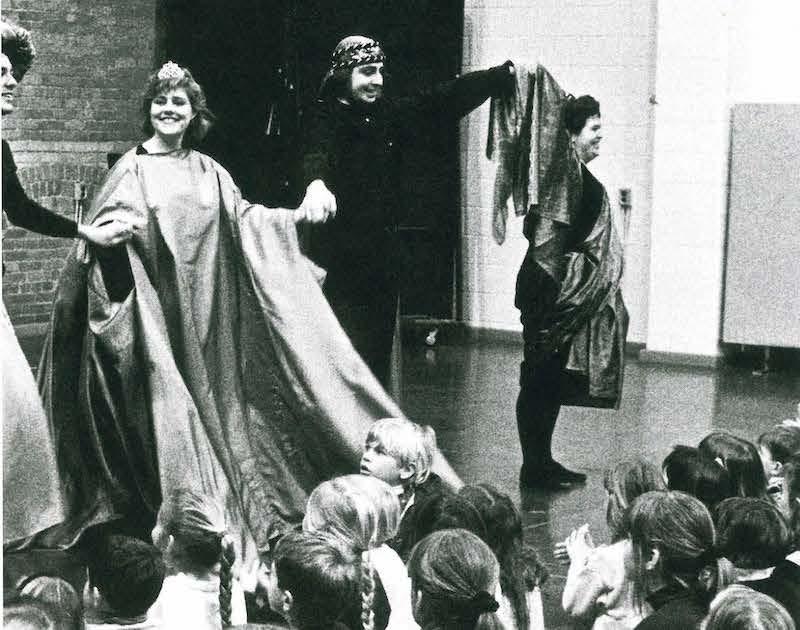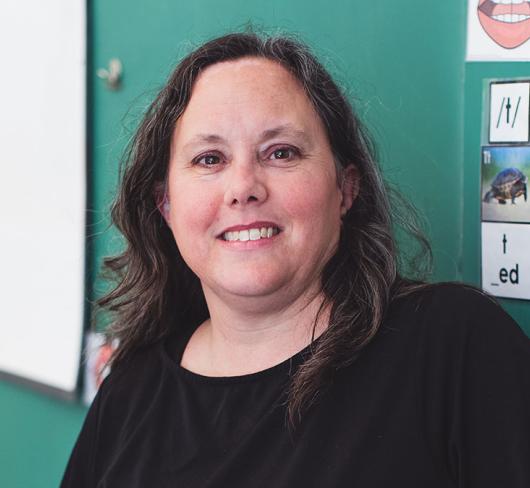
The Importance of Children’s Theatre in Elementary Schools
“I remember watching a young boy, hands stuffed into his pockets, who slunk reluctantly into a gym to see a performance; forced to take his baseball cap off and then wanting to know, ‘Do I have to see this?’ Then as the play began, I watched this boy’s face soften, his shoulders sag, his head craning to catch the action, his head thrown back in laughter. After the performance, this same boy wanted to know, ‘Why did it happen like that? I would have done it like this!” says David S. Craig, Co-Artistic Director, Roseneath Theatre.
For over 20 years, David S. Craig and Robert Morgan have been creating plays for young audiences, wowing students, parents and critics alike with their engaging work. David Craig was the founder and artistic director of Theatre Direct Canada, which, in the late 1970s, was the largest touring theatre company for young audiences in North America. As a writer, David has created over 20 professional productions.
Robert Morgan is well known to young audiences, having written over 20 plays, many of which have toured nationally and internationally. Together, as co-artistic directors of Roseneath Theatre, David and Robert have created and produced many award-winning productions. During the past seven years, Roseneath Theatre has performed for over 500,000 children and adults in Canada and toured in the United States and Great Britain.
Roseneath Theatre has won many awards for its productions: Head à Tête won a Dora Mavor Moore Award (the Toronto equivalent of New York’s Tony Awards); Morgan's Journey and Napalm the Magnificent both won Chalmer’s Canadian Play Awards; and Dib and Dob and the Journey Home won both a Dora and a Chalmer’s Award.
David and Robert believe that theatre demands high-level thinking, mainly because it asks members of the audience to “sit in judgment” on the play’s characters as they make choices within the context of the drama. They write plays that engage the mind, body and spirit of their audience; plays that demonstrate positive types of behaviour. These include respect for different points of view, creative problem solving, risk taking and creative thinking. The authors may work on a play for two years or longer, a very different process than the one used to create children’s television, which is based on a predictable script and formulistic character development.
The two playwrights also believe that children’s rich inner emotional lives are often ignored or played down to in popular entertainment. Although limited by their age, children experience life’s joys and sorrows as powerfully as any adult. Robert and David use these feelings to engage their young audiences. They create dissonance by getting children to question the characters’ values, behaviour and choices. The interaction between the audience and the characters is active (not passive, as it is when watching television), which makes it a captivating way for children to learn.
“Feast - not fast food. Simple - not simplistic. Involve the audience - don’t distract it. Emotionally powerful - not watered down. Talking to - not talking down to. These are the guiding principles and tremendous challenges that face us as we create a production,” says David.
“Einstein said ‘imagination is more important than knowledge.’ That is what makes theatre, and particularly theatre for young audiences, potentially the most powerful educational experience imaginable. Students are hungry to experience this rich, multi-layered expression of life. And theatre for young audiences is the democratic art form - the future baker and garbage collector sit beside the future brain surgeon and astronaut.
“Theatre respects integrity, imagination, beauty, balance and humanity. It achieves all this through a construct that is I completely imagined, not only on the part of the audience f that enters this construct. Theatre, then is an experience of 1 pure imagination,” says David,
“We cannot underestimate the impact of live performance,” says Robert. “To be engaged in anything is fundamental to our growth and happiness. To be engaged as an audience member in an experience of theatre can help us engage more completely with other aspects of life. Theatre is an experience of community. We gather together to watch something about ourselves.”
Children have valuable educational experiences when they go to plays and concerts and visit art exhibits. Live theatre groups, like Roseneath, develop children’s aesthetic sensibilities, promote educational objectives and offer learning opportunities that enhance social awareness and skills.
Students who attend live theatre learn about the behaviour expected from an audience and theatre etiquette. They also learn about the history of theatre, the different styles of theatre and the production skills required to create characters, sets and costumes. Teachers can further meet curriculum expectations by having their students see productions that are tied to topics and themes found in the Ontario provincial curriculum.
For many children, their only experience of live performance is what they get at school assemblies produced by their teachers and peers. Yet professional artists complement and enrich school-based arts programs. According to Stanford University professor Elliot Eisner (1985): “Great art has something unique to provide. The ability to experience such art enlightens in a special way and stretches the mind in the process.”
The value of the arts in education was articulated in Making the Case for Arts Education. This 46-page document, published by the Ontario Arts Council, emphasizes the potential of the arts to enrich students’ lives by “providing an outlet for their creative expression, developing their aesthetic sense, opening their minds to the full range of human experience, and helping them to see and feel the beauty inherent in shape, colour, harmony and movement.”
The arts help children develop higher-level skills such as creativity, problem solving, communication and critical thinking. Not only are these skills essential for success in the classroom, but they are also essential for success in the workplace. Current research shows that students who receive an arts education are more motivated to learn - and stay in school longer. The arts also provide avenues of achievement for students who might otherwise not be successful in school.
Artists and arts educators fear the demise of arts education in Ontario. While the math and language curriculums were implemented with some additional funding for textbooks, teacher resources and supplies, many boards have had to implement the new Ontario arts curriculum without additional funding. At the same time as the government is starving arts education, Brenda Protheroe, Chief EQAO Assessment Officer, says the total life-cycle budget for grade 3 and grade 6 assessments was approximately $12 million (1998/1999 figures).
Teacher training in the arts continues to be a challenge. For example, pre-service teachers in Ontario continue to receive less than 50 hours of instruction in the arts while jurisdictions in Britain and elsewhere require student teachers to take 400 hours of instruction.
Noted author and educator Walter Pitman described the problem associated with teacher training in the arts as follows: “The latest elementary arts curriculum is big on outcomes, such as every Grade 3 student should write a song, but shows no way how to get there. Teachers don’t know how to write a song. They don’t know how to read music ... the era of vertical learning in which students learn more and more about less and less needs to come to an end,” he said.
Meanwhile, artists like Robert Morgan and David Craig fear that without adequate teacher training, and a funding formula which supports the live theatre experience, the next generation will be deprived of meaningful arts experiences.
The arts are a way for us to make meaning out of our deepest feelings and most significant thoughts. “The most important aspects of civilization and culture are preserved, not in standardized tests or on report cards but in imaginative literature, art, drama, dance and music. And these are the ancient learning rhythms that draw contemporary children. The arts were and remain the most basic and essential forms of human communication” (Cornett, 2000).
Jim Giles teaches grade 3 at Queen Victoria Public School, Toronto. He also teaches drama for the Primary/Junior A.Q. Course at the University of Toronto and will be teaching again this summer at the Maliburton School of the Arts. He has taught the Integrated Arts A.Q. Course at York University.
References:
Cornett, Claudia E., and Katherine L. Smithrim. The Arts as Meaning Makers - Integrating Literature and the Arts Throughout the Curriculum (Canadian edition). Toronto: Prentice-Hall. 2000.
Eisner, Elliott. “Why Art in Education and Why Arts Education.” Beyond Creating: The Place for Art in American Schools. Los Angeles: Getty Center for Education in the Arts. 1985.
Kuroyanagi, T. Totto-Chan. Tokyo: Kodansha International. 1984.
Ontario Arts Council. Making the Case for Arts in Education. Toronto. 1987.

